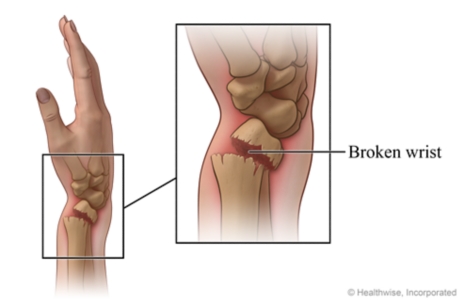Colles Fracture in Children: Care Instructions

Overview
A Colles (say "CALL-us" or "CALL-eez") fracture is a specific type of broken wrist. In this type of fracture, the broken bone in your child's wrist tilts upward when the hand is palm down. These breaks may happen when children throw their hands up to protect themselves when falling. Your child's treatment depends on how bad the break is.
The doctor may have put your child's wrist in a cast or splint. This will help keep your child's wrist stable and keep the bone in the right position. Sometimes surgery is needed to help keep the bone in position for good healing.
It will take several weeks to a few months for the wrist to heal. You can help it heal with care at home.
Your child may have had a sedative to help them relax. Your child may be unsteady after having sedation. It takes time (sometimes a few hours) for the medicine's effects to wear off. Common side effects include nausea, vomiting, and feeling sleepy or cranky.
The doctor has checked your child carefully, but problems can develop later. If you notice any problems or new symptoms, get medical treatment right away.
Follow-up care is a key part of your child's treatment and safety. Be sure to make and go to all appointments, and call your doctor or nurse advice line (811 in most provinces and territories) if your child is having problems. It's also a good idea to know your child's test results and keep a list of the medicines your child takes.
How can you care for your child at home?
- Be safe with medicines. Read and follow all instructions on the label.
- If the doctor gave your child a prescription medicine for pain, give it as prescribed.
- If your child is not taking a prescription pain medicine, ask your doctor if your child can take an over-the-counter medicine.
- Put ice or a cold pack on your child's arm for 10 to 20 minutes at a time. Try to do this every 1 to 2 hours for the next 3 days (when your child is awake). Put a thin cloth between the ice and the cast or splint. Keep the cast or splint dry.
- Follow the splint or cast care instructions that the doctor gives you. If your child has a splint, do not take it off unless the doctor tells you to. Be careful not to put the splint on too tight.
- Prop up your child's wrist on pillows when your child sits or lies down in the first few days after the injury. Keep your child's wrist higher than the level of the heart. This will help reduce swelling.
- Have your child move the fingers often to reduce swelling and stiffness. But tell your child not to use that hand to grab or carry anything.
- Follow instructions for exercises to keep your child's arm strong.
When should you call for help?
Call 911 anytime you think your child may need emergency care. For example, call if:
- Your child has trouble breathing. Symptoms may include:
- Using the belly muscles to breathe.
- The chest sinking in or the nostrils flaring when your child struggles to breathe.
- Your child is very sleepy and is hard to wake up.
- Your child passes out (loses consciousness).
Call your doctor or nurse advice line now or seek immediate medical care if:
- Your child has new or worse nausea or vomiting.
- Your child has new or worse pain.
- Your child's hand or fingers are cool or pale or change colour.
- Your child's cast or splint feels too tight.
- Your child has tingling, weakness, or numbness in the hand or fingers.
Watch closely for changes in your child's health, and be sure to contact your doctor or nurse advice line if:
- Your child has problems with the cast or splint.
- Your child does not get better as expected.
Where can you learn more?
Go to https://www.healthwise.net/patientEd
Enter O125 in the search box to learn more about "Colles Fracture in Children: Care Instructions".
Current as of: July 31, 2024
